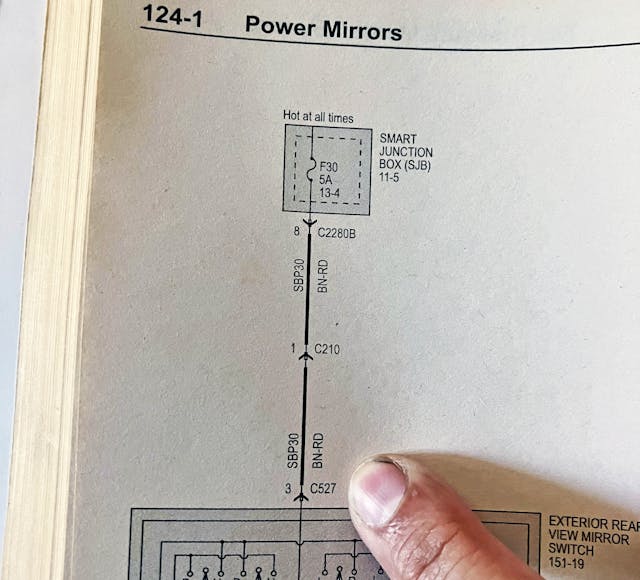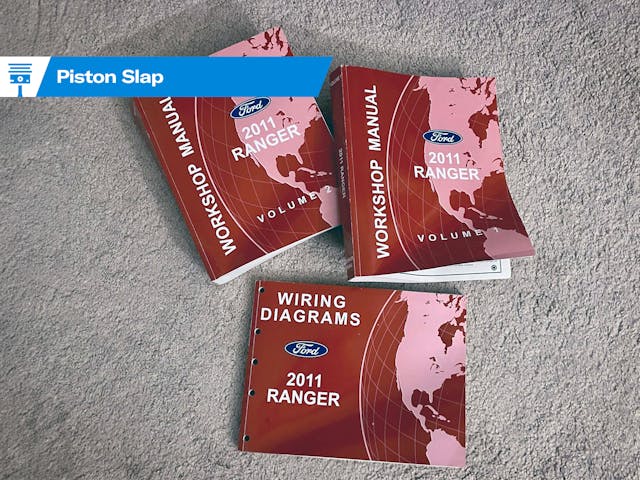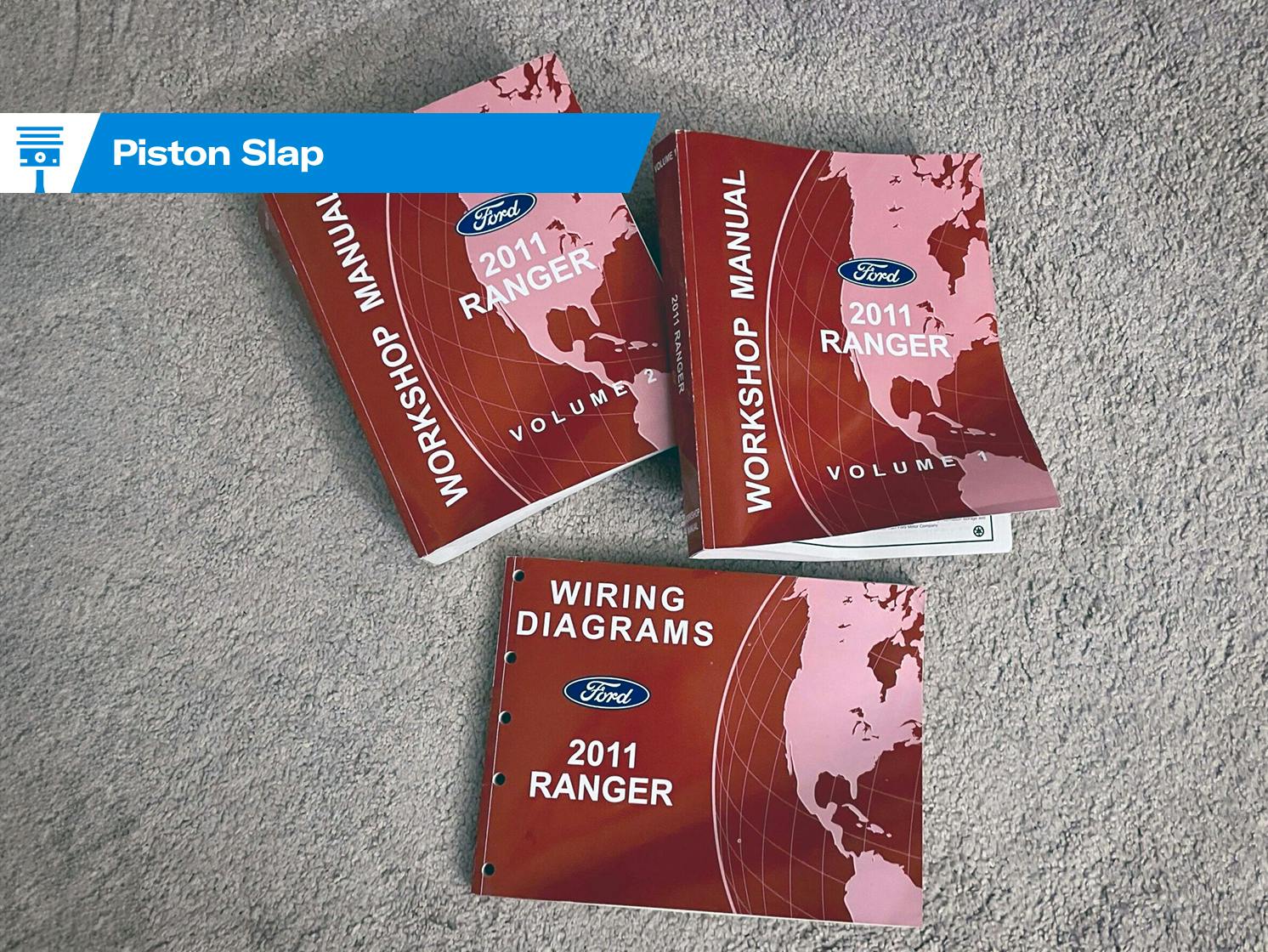Media | Articles
Piston Slap: The Need For Repair Manuals in Modern Internet Times
Adam writes:
Sajeev,
I have a 2011 Ford Ranger Super Cab 4×4 4.0 Sport with 52,000 miles on it. I bought it in 2014 with 7000 miles, so I know its history pretty well. Recently, the power mirrors stopped working. I checked the fuse, and the 5 amp was burned out. I replaced the fuse, and the power mirror started to work again. However, when I started up the truck, I immediately heard the 5 amp fuse blow again.
I checked, and it looks like the power mirrors are the only thing on the circuit, per the wiring diagram on the Internet, so I know I have to take that with a grain of salt. I decided to unplug the power mirror switch and replace the fuse. I thought the switch could be the cause. When I went to get back in the truck (the fuse box is on the passenger side footwell) I swear I heard it blow again as soon as I opened the driver’s door.
Do you have any suggestions on how I could track down this issue? I have Googled several videos, but most find dead shorts like this due to body damage or a wiring harness that was compromised due to corrosion or something really wild.
Marketplace
Buy and sell classics with confidence
I saw a YouTube video on the South Main Auto channel where the fuse kept blowing on an Altima and after replacing the throttle body. A new fuse box and it was brought to him to replace the ECM. He decided to run down the wiring and traced it down a comprised wire in the cowl. Apparently, the factory did not clip in the wiring harness, and it was resting on the wiper armature and eventually cut through the one wire that controlled the throttle body.
Besides something crazy like that, any thoughts of what it could be?
Thank you,
Adam
P.S. I do have an official 2011 Ford Ranger Work Shop Manual and Wiring Diagram I ordered off of eBay last night.
Sajeev answers:
No, that wiring issue you saw on YouTube is not a “crazy” thing to happen. A short to ground fault is likely your issue, but before we go there, I suggest wiring problems are downright commonplace with modern cars.
There are plenty of fail points in a modern supply chain, so you have to be ready for anything. The factory can forget to fully push in a retainer, install a clip, etc., which eventually causes a wire to chafe on something else. Or perhaps a wiring harness vendor can forget to add said clip or retainer at a specific location? Sometimes the automaker even “forgets” to design it into the wiring harness in the first place!
This is why I am glad you bought the shop manual and wiring diagrams, since you absolutely need them. And since this might one day apply to my 2011 Ford Ranger, I dug into my wiring diagram to see what should be done. At least in theory.

Page 124-1 suggests you need to check a BR-RD wire (Brown with a Red stripe) from the fuse box, inspecting its entire length for a problem. The first connector (C527) to check for damage is the one at the switch that you already disconnected, so it’s probably not your issue. But look at the condition of the BR-RD wire at the plug, and examine the harness for signs of damage.
The second connection for the BR-RD wire at C210, inside the dash, above the pedal assembly. The BR-RD wire at C210 is the first pin in the harness. (Look at page 150-26 of the manual to see what I see). Inspect and disconnect C210 and test again. This is also a good time to note there are better tools for testing a short to ground than a handful of new fuses.
This video will get you the rest of the way, but usually a short to ground happens when accident damage repair, aftermarket parts, or general sloppiness in labor causes a wire to wind up in a place it doesn’t belong. Best of luck to you, though it should be quite easy in a vehicle this simple.
Bonus! A Piston Slap Nugget of Wisdom
YouTube is a great motivator and educator, but nobody ever pulls up wiring diagrams to show you wire colors and locations of where you need to go. I mean nobody. Who would be that detail oriented in a YouTube video?
Well, except for this dork who can’t even hold a phone while making a video. What an amateur!
Bottom line: Use Facebook Groups, YouTube Videos, and even car forums for the advice to set you in the right direction. But when its your turn at the problem, getting factory shop manuals and ESPECIALLY wiring diagrams are mandatory for any do-it-yourselfer. They aren’t cheap, but they pay for themselves after a few repairs on most any vehicle in the last 30-40 years.
Have a question you’d like answered on Piston Slap? Send your queries to pistonslap@hagerty.com—give us as much detail as possible so we can help! Keep in mind this is a weekly column, so if you need an expedited answer, please tell me in your email.
***
Check out the Hagerty Media homepage so you don’t miss a single story, or better yet, bookmark it. To get our best stories delivered right to your inbox, subscribe to our newsletters.













Factory manuals are great but so expensive anymore.
Knew they are $450 for my car and used about $175. 3 volumes.
A small price to pay, as any decent repair shop in my area now charges $150/hr in labor…
I don’t mind paying for hard copies, but too many are only available digitally.
I’d much rather have a digital manual. Print the pages you need when you need them. If they get destroyed, print them again. Paper manuals get ruined easliy enough.
I’d argue that “paying for themselves” might reach even further than 30-40 years, Sajeev. My car is almost 60, and I still consult my manuals for a ton of things. 😉
Very true, but I wonder aloud if you don’t need factory manuals for older cars and any manual (Haynes, etc) would suffice due to their relative simplicity? Every time I have used a Ford shop manual for a pre-74 car I’ve found it far less helpful. I should get an old Haynes and see if its thinned down information is adequate.
I get what you’re saying, but to my knowledge, no Haynes manual exists for a 1966 Pontiac, let alone the Tempest/LeMans/GTO A-Body models. But even if it does (willing to be proven wrong!), I’d submit that when I need to consult a manual, it isn’t for something “relatively simple”. I’m digging for some mundane detail that is not generally found in “thinned down” formats. A few years back, I needed to completely understand how the windshield washer pump functioned – from pushing the button in the center of the dash knob to making fluid squirt onto the glass to activating the wiper motor for intermittent swipes. I have several books on these cars – including restoration manuals – and couldn’t find anything tracing how all of those parts interacted. When I pulled out my factory manual, I found (and yes, it was technically complex) the information I needed. I was finally to figure out where my system was faulty and fix it.
Yeah that makes a lot of sense. Even with the factory shop manual and wiring diagrams I could not figure out what was wrong with my 72 Mark IV’s automatic headlight system, but I guess it did come in handy for me to bypass the system and just work manually with the headlight switch. 🙂
I think he meant that it’s especially true for vehicles built in the last 20-30 years
The very first thing I did after purchasing my 1996 Jaguar XJ12 Sedan, was to get the paper set of manuals from Jaguar. Just under $300.00 but saved 1300 in electrical repairs the first time I opened it.
Internet help with car problems is an interesting story. Back in the day, people posted help tutorials on web boards with imbedded images hosted on sites that specialized in hosting images. These were very useful because you didn’t have to listen to some guy gas off for 5 minutes before seeing what you need to see
Apparently a lot of the image hosting sites stopped hosting for free and started charging. This pretty much killed text/image based help, and now everything is video
As for your problem, pop the door panels and look for something snagged up inside the door. Also check out the flexible joint between the door and the body that the wires run through. These are the first two spots I would check. It is also possible that one of the mirror motors themselves is faulted. Happy hunting
The very first thing I did after purchasing my 1996 Jaguar XJ12 Sedan, was to get the paper set of manuals from Jaguar. Just under $300.00 but saved 1300 in electrical repairs the first time I opened it. Turned out to be an AWU circuit wire in the passengers front door, that allowed the window to be operated from the passengers door switch, but not from the drivers master switch. (AWU = All Windows Up) feature in the XJ12 and VdP models that made sure AWU before locks would engage.
@Sajeev, I absolutely agree, service manuals will pay for themselves for the DIYers. I have purchased one for every vehicle I have owned since my 88 Fiero GT. They have been of imense help, especially when we didn’t have an internet. I’m sure I’ve spent a couple thousand on service manuals. I don’t even bother with Haynes or Chilton manuals anymore. Now, if only we could deal with all the special tools required, that would be wonderful.
The downside of all this “non-accessibility” (price-wise) of these highly-priced digitized manuals, is that in the long run, DIY people like myself are becoming less & less familiar with the mechanical basics of ICE (internal combustion engined) of modern vehicules. Even if we have access to expensive digitized manuals, the modern day mechanics have become ultra-complicated & usually necessitate On-Board Diagnostic tools & many more other specialized tools, plus the obvious hands-on expertise needed to succeed in DIY jobs. The “Right-To-Repair” principle is really, really tough & costly to apply in modern day automotive mechanics, namely because of complicated on-board computers basically regulating all inter-connected component systems. Conclusion: I’ll continue to use my ‘ol HAYNES manuals for my MGB & Big Healey to keep my ” Old School Mechanical Skills” alive & well, while waiting for the less-expensive EV’s to come along!!
The amount of times that I have thrown old-school diagnostic techniques at newer cars… and it worked has convinced me that all of the electronic wizardry has not changed the fundamentals of how these machines work. I am 3 for 3 of fixing long-standing check engine lights with a smoke machine, a pair of eyeballs, and some general sleuthing for things that don’t look right
I’d be looking at the door jam wiring, since it is flexed with door/open close. A common fail point on most cars. Also a good spot to isolate door from rest of car. If anyone needs a mid 90’s GM manual, I have many. I wrote GM manuals when I worked for EDS in Flint. No one seems to want mid 90’s GM manuals anymore.
I bet if you put them all on eBay (as individual auctions) at market price and keep on re-running the auctions for a year, your collection will thin down significantly.
Good idea! Thanks, Sir.
Good luck. 🙂
I work on a fleet of Ford Transits that aren’t very old, what a POS those trucks are. Besides the after treatment on the South African built I-5 diesel, every truck at about 60-70k needs the drivers door harness because on or more power windows quit working, the done light stays on or constant messages to shut the door. Pull the wiring out of the rubber boot and several wires insulation have already hardened and fallen off or broke in such a short time. Did I mention what a POS truck that is ???
I always buy a Haynes day one. They’re useful but also inaccurate many times. I suspect their claim that they tore the car down bolt by bolt is a bit deceiving to say the least. A decent start but only that. The only manual that I’ve ever had that really worked was “Fix Your Ford ” or, as I refer to it , The Bible. But those were much simpler times.
Our business is selling used shop manuals (EthylsGarage.com). We find that most of our customers will download a cheap PDF manual from eBay first in the vain hope the can find the information they need. Then they discover just exactly how hard it is to read a wiring diagram on their phone. Then they come to us for the paper manuals. Unless you are a professional mechanic with a 36″ display on top of your Snap-On cabinet most enthusiasts don’t have the ability to conveniently use the currently available electronic manuals. Our mission is to keep the paper manuals available for all.
Valuable service, IMO. Carry on! 👍
I have the factory manuals for my Supra. I would never part with them, always valuable.
When I am trying to find a direct short in a system I will sometimes replace the fuse in the circuit with an old 12v headlight bulb out of a junk car or motorcycle. When the short occurs the bulb will get much brighter.This has saved me a lot of fuses. I must be an old school guy, I much prefer a paper copy to a on line manual any day. I always forget the password.